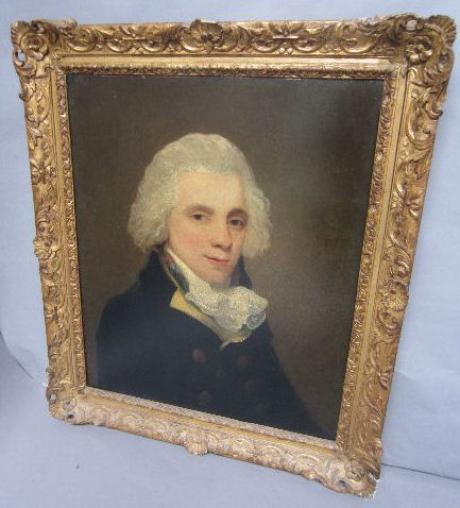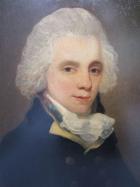Abbott, Lemuel Francis [Samuel] (1760/61–1802), portrait painter, was the elder son of a clergyman in Leicestershire—probably the Revd Lemuel Abbott (d. 1776), curate of Anstey, later vicar of Thornton, and his wife, Mary. In 1775, at the age of fourteen, he was apprenticed to Francis Hayman, after whose death in the following year he returned to his parents and apparently continued to study portrait painting independently. About 1780 he settled in London, and resided for many years in Caroline Street, Bloomsbury. On 16 November 1786 he married Anna Maria Magdalen Tracey at St George the Martyr, Queen Square, London. Their son Edward Francis Abbott was born on 20 December 1787. Between 1788, when he was a candidate for election as an associate of the Royal Academy, and 1800 he showed fifteen male portraits at the Royal Academy and seems to have specialized in painting portraits of diplomatists, colonial governors, and senior naval officers. The heads of his male portraits were accurate likenesses, particularly his naval portraits, examples of which are in the National Maritime Museum, London, notably the half-length of Nelson (who sat to him several times), shown at the Royal Academy in 1800, and the whole-length of Sir Peter Parker. Several commentators have noted the weakness of his whole-length poses. His portraits of the poet William Cowper (1792) and the sculptor Joseph Nollekens are in the National Portrait Gallery, London. His portraits were engraved by Valentine Green, Joseph Skelton, and William Walker among others. Although it was said that his parsimonious disposition led him to engage no assistants, with the result that he was overwhelmed with commissions he could not fulfil, it is known that the sporting painter Ben Marshall was apprenticed to him for three years in 1791.
By July 1798 Abbott was certified insane. It has been supposed that insanity was due to an ‘ill-assorted marriage’ (Redgrave, Artists, 1), though Abbott referred in his will of October 1800 to his ‘dear wife’, who was his executrix and beneficiary. He last exhibited at the Royal Academy in 1800. Abbott died at his home in Penton Street, Clerkenwell, London, on about 5 December 1802. Waterhouse noted that his unfinished works were completed by a ‘less sensitive hand’ (Waterhouse, 18c painters, 21). Farington noted in his diary on 25 January 1803 that Abbott died ‘about six weeks ago’ ‘in a State of Insanity. A commission of Lunacy had been taken out & it then proved that He was not possessed of more than 3 or 400 pounds a year’ (Farington, Diary, 5.1966). On 17 August Farington noted that during a visit to Nollekens:
a boy near 16 years of age was drawing upon a Slate from a Plaister figure. Nollekens told me He was the only son of the late Mr. Abbot, Portrait Painter. His mother is a Roman Catholic & a Bigot. She insists upon Her Son becoming a Romish Priest, which He refuses, & she will in consequence scarcely see him. (ibid., 6.2109)
A. Nisbet DNB



